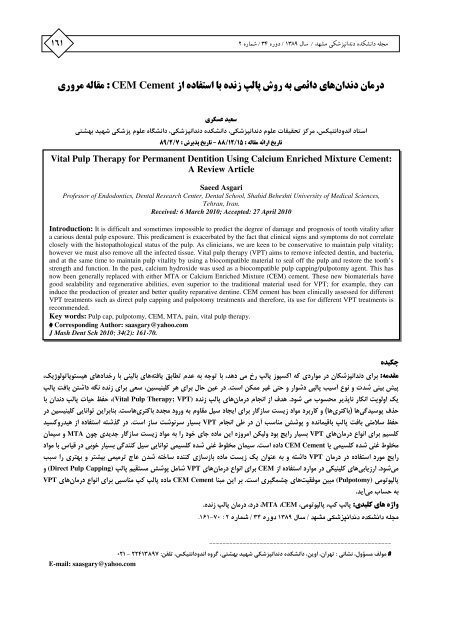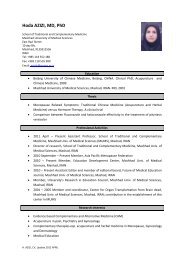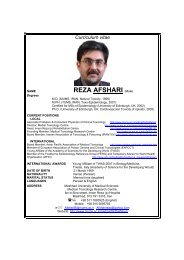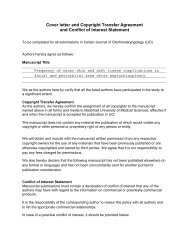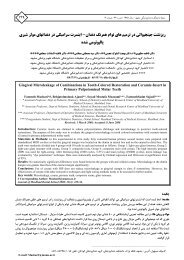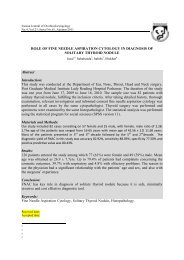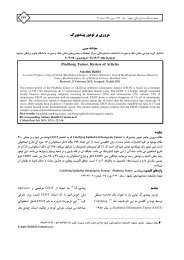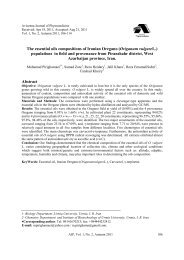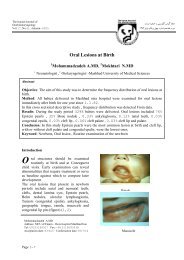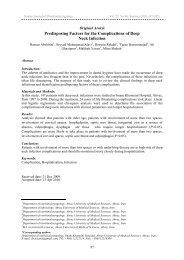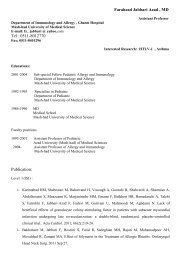> CEM Cement :
> CEM Cement :
> CEM Cement :
- No tags were found...
You also want an ePaper? Increase the reach of your titles
YUMPU automatically turns print PDFs into web optimized ePapers that Google loves.
1612 / 34 / 1389 / : <strong>CEM</strong> <strong>Cement</strong> 89/2/7 : – 88/12/15 : Vital Pulp Therapy for Permanent Dentition Using Calcium Enriched Mixture <strong>Cement</strong>:A Review ArticleSaeed AsgariProfessor of Endodontics, Dental Research Center, Dental School, Shahid Beheshti University of Medical Sciences,Tehran, Iran.Received: 6 March 2010; Accepted: 27 April 2010Introduction: It is difficult and sometimes impossible to predict the degree of damage and prognosis of tooth vitality aftera carious dental pulp exposure. This predicament is exacerbated by the fact that clinical signs and symptoms do not correlateclosely with the histopathological status of the pulp. As clinicians, we are keen to be conservative to maintain pulp vitality;however we must also remove all the infected tissue. Vital pulp therapy (VPT) aims to remove infected dentin, and bacteria,and at the same time to maintain pulp vitality by using a biocompatible material to seal off the pulp and restore the tooth’sstrength and function. In the past, calcium hydroxide was used as a biocompatible pulp capping/pulpotomy agent. This hasnow been generally replaced with either MTA or Calcium Enriched Mixture (<strong>CEM</strong>) cement. These new biomaterials havegood sealability and regenerative abilities, even superior to the traditional material used for VPT; for example, they caninduce the production of greater and better quality reparative dentine. <strong>CEM</strong> cement has been clinically assessed for differentVPT treatments such as direct pulp capping and pulpotomy treatments and therefore, its use for different VPT treatments isrecommended.Key words: Pulp cap, pulpotomy, <strong>CEM</strong>, MTA, pain, vital pulp therapy.# Corresponding Author: saasgary@yahoo.comJ Mash Dent Sch 2010; 34(2): 161-70. : . (Vital Pulp Therapy; VPT) . . () . VPT MTA VPT . <strong>CEM</strong> <strong>Cement</strong> VPT (Direct Pulp Capping) VPT <strong>CEM</strong> .VPT <strong>CEM</strong> <strong>Cement</strong> . (Pulpotomy) . . MTA <strong>CEM</strong> : .161-70 : 2 / 34 1389 / E-mail: saasgary@yahoo.com------------------------------------------------------021 - 22413897 : : #
( )... 162 ( ) (9) (DPC) (10).( ) (RCT) (11). . . (12). (Self-strangulation theory) VPT(13). ( ) .: VPT(14). (1) . - ( ) (2-3) . (4). » (5). 2 « ) » (DPC) . (6) VPT VPT 1« (7). () ( ) (8). (Evidence Base) 1. Vital Pulp Therapy (V.P.T)2. Direct Pulp Cap (D.P.C)
1632 / 34 / 1389 / -1 <strong>CEM</strong> MTA . <strong>CEM</strong> Enterococcus faecalis Staphylococcus aureusPseudomonas aeruginosaEscherichia coli <strong>CEM</strong>(22-24).MTA MTA Candida Albicans 24 IRM 2(25). -2 <strong>CEM</strong> MTA
( )... 164 . CH <strong>CEM</strong> (21).(2) MTA <strong>CEM</strong> (33).(3 ) <strong>CEM</strong> . <strong>CEM</strong> Case series .(4 ) <strong>CEM</strong> 16 (20).(5) <strong>CEM</strong> . 2 <strong>CEM</strong> -3 MTA MTA <strong>CEM</strong> <strong>CEM</strong> <strong>CEM</strong>MTA <strong>CEM</strong> Flow(Film Thickness)MTA. MTA <strong>CEM</strong> <strong>CEM</strong>MTT(HGF)MTA(29).-4 (4-1<strong>CEM</strong> L929 . (3031) IRM MTAMTA(32). <strong>CEM</strong> (4-2 (19).(1MTA<strong>CEM</strong>) (4-3 MTA,CH, <strong>CEM</strong>
1652 / 34 / 1389 / . . . . . . . . . . .(6 ) . . Post <strong>CEM</strong>-5 . .<strong>CEM</strong>. MTA MTA (3435). <strong>CEM</strong> (PBS) (36).
( )... 166 Pear shape . -1 . -2 ( ). " " -3. " " " " -4 . <strong>CEM</strong> -5 . . . 5 . (37) VPT . )(<strong>CEM</strong> <strong>Cement</strong>) .( 1 3 . . . ) . ( . SS Crown
1672 / 34 / 1389 / - . - : (A): 1 (Tunnel Defect) - . - :MTA (B) .( ):(<strong>CEM</strong>) (C) . . - - . -.(19 ) .- . - :MTA (A): 2 - : (B) . - . - :<strong>CEM</strong> (C) . - . .(21 )
( )... 168 (b) . 8 (a): 3 (d) . (c) . <strong>CEM</strong> (e) .() .(33 ) (<strong>CEM</strong>) ( ) (a): 4 (b) . . <strong>CEM</strong> (c) . <strong>CEM</strong> .( ) . (a): 5 . . ( ) <strong>CEM</strong> (b) (d) . (c) . .(20 ) <strong>CEM</strong>
1692 / 34 / 1389 / ) (A): 6 (b) . . ( <strong>CEM</strong> (c) . <strong>CEM</strong>. 1. Hicks MJ, Flaitz CM. Epidemiology of dental caries in the pediatric and adolescent population: A review ofpast and current trends. J Clin Pediatr Dent 1993; 18(1): 43-9.2. Toldo V. Necrosis and gangrene of the pulp in teeth undamaged by caries. Riv Ital Stomatol 1952; 7(5): 581-97.3. Tagger M, Massler M. Periapical tissue reactions after pulp exposure in rat molars. Oral Surg Oral Med OralPathol 1975; 39(2): 304-17.4. Robertson A, Andreasen FM, Andreasen JO, Norén JG. Long-term prognosis of crown-fractured permanentincisors. The effect of stage of root development and associated luxation injury. Int J Paediatr Dent 2000; 10(3):191-9.5. Shabahang S, Torabinejad M. Treatment of teeth with open apices using mineral trioxide aggregate. PractPeriodontics Aesthet Dent 2000; 12(3): 315-20.6. Katebzadeh N, Dalton BC, Trope M. Strengthening immature teeth during and after apexification. J Endod1998; 24(4): 256-9.7. Cvek M. Prognosis of luxated non-vital maxillary incisors treated with calcium hydroxide and filled with guttapercha.A retrospective clinical study. Endod Dent Traumatol 1992; 8(2): 45-55.8. Miyashita H, Worthington HV, Qualtrough A, Plasschaert A. Pulp management for caries in adults: maintainingpulp vitality. Cochrane Database Syst Rev 2007; 18 (2): CD004484.9. Cox CF, Bergenholtz G, Fitzgerald M, Heys DR, Heys RJ, Avery JK, et al. Capping of the dental pulpmechanically exposed to the oral microflora - a 5 week observation of wound healing in the monkey. J OralPathol 1982; 11(4): 327-39.10. Pulpitis. Available at: URL: http://en.wikipedia.org/wiki/Pulpitis11. Kakehashi S, Stanley HR, Fitzgerald RJ. The effects of surgical exposures of dental pulps in germfree andconventional laboratory rats. J South Calif Dent Assoc 1966; 34(9): 449-51.12. Witherspoon DE. Vital pulp therapy with new materials: new directions and treatment perspectives-permanentteeth. J Endod 2008; 34(7 Suppl): S25-8.13. Yamasaki M, Kumazawa M, Kohsaka T, Nakamura H, Kameyama Y. Pulpal and periapical tissue reactionsafter experimental pulpal exposure in rats. J Endod 1994; 20(1): 13-7.14. Tziafas D, Smith AJ, Lesot H. Designing new treatment strategies in vital pulp therapy. J Dent 2000; 28(2):77-92.15. Stanley HR. Criteria for standardizing and increasing credibility of direct pulp capping studies. Am J Dent1998; 11: S17-34.
( )... 17016. Kiba H, Hayakawa T, Nakanuma K, Yamazaki M, Yamamoto H. Pulpal reactions to two experimental bondingsystems for pulp capping procedures. J Oral Sci 2000; 42(2): 69-74.17. Eghbal MJ, Asgary S, Baglue RA, Parirokh M, Ghoddusi J. MTA pulpotomy of human permanent molars withirreversible pulpitis. Aust Endod J 2009; 35(1): 4-8.18. Asgary S, Eghbal MJ, Parirokh M. Sealing ability of novel endodontic cement as a root-end filling material. JBiomed Mater Res A 2008; 87(3): 706-9.19. Asgary S, Eghbal MJ, Parirokh M, Ghanavati F, Rahimi H. A comparative study of histologic response todifferent pulp capping materials and novel endodontic cement. Oral Surg Oral Med Oral Pathol Oral RadiolEndod 2008; 106(4): 609-14.20. Asgary S, Ehsani S. Permanent molar pulpotomy with new endodontic cement: A case series. J Conserv Dent2009; 12(1): 31-6.21. Tabarci B, Parirokh M, Eghbal MJ, Haghdoost AA, Torabzadeh H, Asgary S. A comparative study of dentalpulp response to different pulpotomy agents in dogs. Int Endod J. (In Press)22. Asgary S, Kamrani FA. Antibacterial effects of five different root canal sealing materials. J Oral Sci 2008;50(4): 469-74.23. Hasan Zarrabi M, Javidi M, Naderinasab M, Gharechahi M. Comparative evaluation of antimicrobial activity ofthree cements: New endodontic cement (NEC), mineral trioxide aggregate (MTA) and Portland. J Oral Sci2009; 51(3): 437-42.24. Asgary S, Akbari Kamrani F, Taheri S. Evaluation of antimicrobial effect of mineral trioxide aggregate,calcium hydroxide, and <strong>CEM</strong> cement. IEJ 2007; 2(3): 105-9.25. Kangarlou A, Sofiabadi S, Yadegari Z, Asgary S. Antifungal effect of Calcium Enriched Mixture (<strong>CEM</strong>)cement against Candida Albicans. IEJ 2009; 4(3): 101-5.26. Asgary S, Eghbal MJ, Parirokh M, Torabzadeh H. Sealing ability of three commercial mineral trioxideaggregates and an experimental root-end filling material. IEJ 2006; 1(3): 101-5.27. Hasheminia M, Loriaeinejad S, Asgary S. Sealing ability of MTA and a new endodontic material as root-endfillings in dry, saliva or blood-contaminated conditions. In: 2 nd IADR Iranian Section General Meeting; 2007Dec 6-7; Tehran, Iran.28. Zafar M, Iravani M, Eghbal MJ, Asgary S. Coronal and apical sealing ability of new endodontic cement. IEJ2009; 4(1): 15-9.29. Asgary S, Shahabi S, Jafarzadeh T, Amini S, Kheirieh S. The properties of a new endodontic material. J Endod2008; 34(8): 990-3.30. Ghoddusi J, Tavakkol Afshari J, Donyavi Z, Brook A, Disfani R, Esmaeelzadeh M. Cytotoxic effect of a newendodontic cement and mineral trioxide aggregate on L929 line culture. IEJ 2008; 3(2): 17-23.31. Asgary S, Moosavi S, Yadegari Z, Shahriari S. Cytotoxic effect of MTA and New Endodontic <strong>Cement</strong> inhuman gingival fibroblast cells: A SEM evaluation. NY State Dent J 2009 (In Press).32. Mozayeni M, Salem Milani A, Alim Marvasti L, Asgary S. Cytotoxicity of new ceramic enriched mixture(<strong>CEM</strong>) compared with MTA and IRM. Aust Endod J (In Press).33. Nosrat A, Asgary S. Apexogenesis treatment using new endodontic cement: A case report. J Endod 2010 (InPress)34. Asgary S, Eghbal MJ, Parirokh M, Ghoddusi J. Effect of two storage solutions on surface topography of tworoot-end fillings. Aust Endod J 2009; 35(3): 147-52.35. Asgary S, Eghbal MJ, Parirokh M, Ghoddusi J, Kheirieh S, Brink F. Comparison of mineral trioxide aggregate'scomposition with Portland cements and a new endodontic cement. J Endod 2009; 35(2): 243-50.36. Ghorbani Z, Kheirieh S, Shadman B, Eghbal MJ, Asgary S. Microleakage of <strong>CEM</strong> cement in two differentmedia. IEJ 2009; 4(3): 87-90.37. Silva AF, Tarquinio SB, Demarco FF, Piva E, Rivero ER. The influence of haemostatic agents on healing ofhealthy human dental pulp tissue capped with calcium hydroxide. Int Endod J 2006; 39(4): 309-16.


